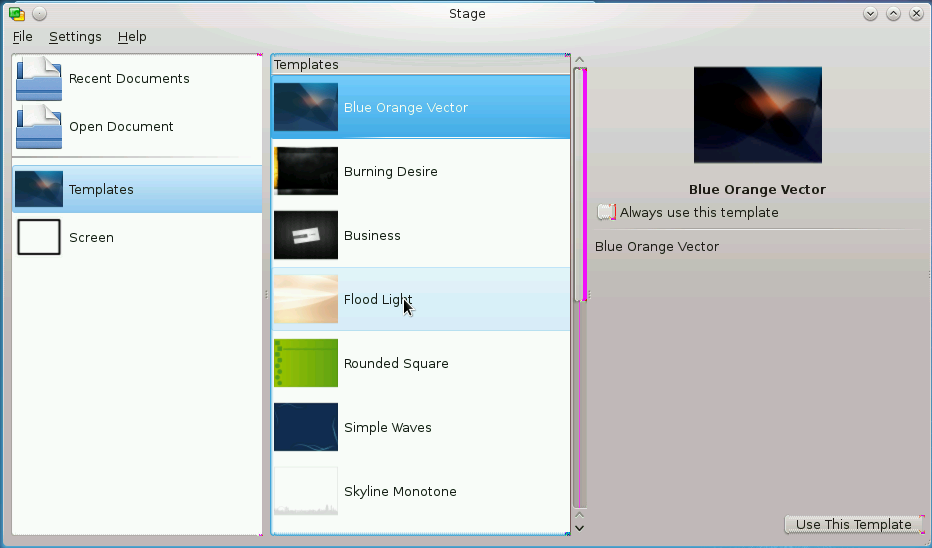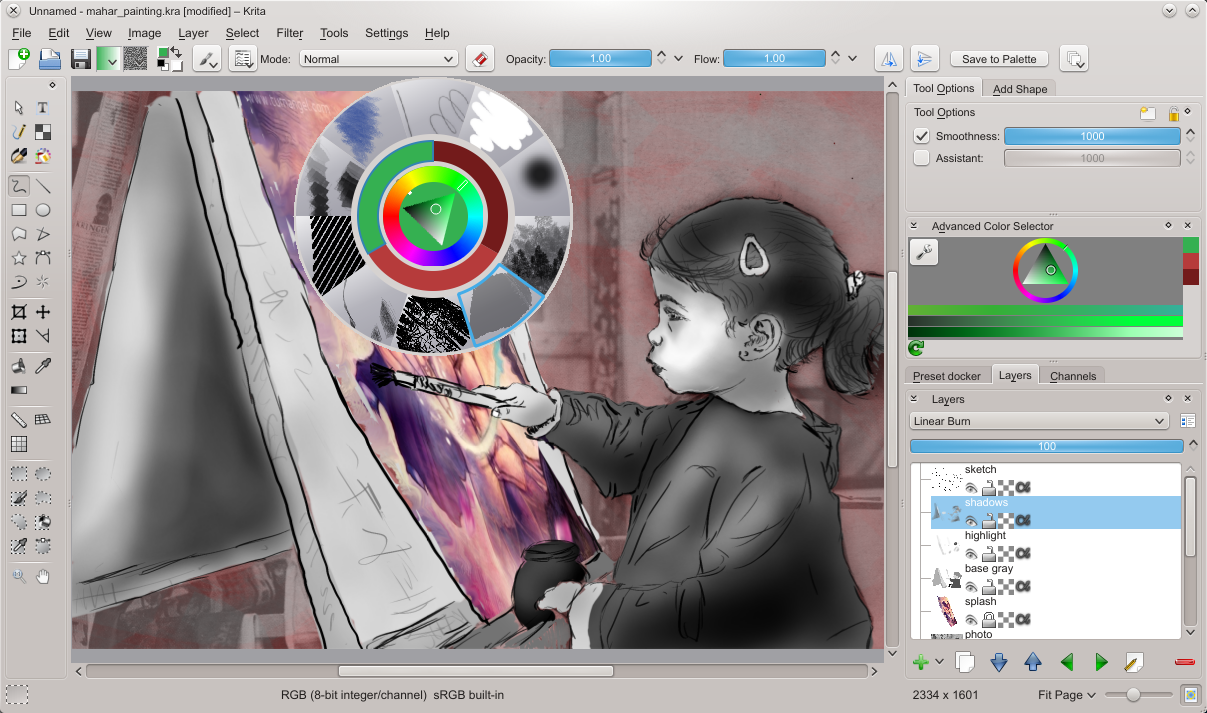Once upon a time there was KOffice, all full of unrealized potential. And then it was forked as Calligra Suite. The first release of Calligra was on April 11, 2012. Is this a contender, or another niche productivity suite?
It’s a tough row to hoe, building an office suite. The applications are complex, even without thinking about interoperability. Microsoft Office is the tail that has long wagged the office suite dog, with all of its flaws and lard and barriers to interoperability and portable data. If an office suite doesn’t have MS Office compatibility it’s going to appeal to a limited audience. But times change, and now the Open Document Format (ODF) is nearly universal, which (theoretically) means that we can open our files in any application that supports ODF. And thus even the most stubborn titan of lock-in must eventually succumb, and now even MS Office claims ODF support.
ODF is an official ISO/IEC standard. ODF 1.2 is the current release, which came out in September 2011. The first release, ODF 1.1, has been around since May 2005. Having an official standard does not magically ensure harmony. Implementation isn’t always perfect, there are usually ambiguities in the standard, and vendors just can’t resist adding their own custom non-standard extensions. Sometimes there are even sneaky little patent bombs in standards. If you have rosy dreams of being able to open any of your data files in any program flawlessly, dream on. Still, it’s considerably better than in the olden days. Because ODF is a plain-text XML format, there will always be a way to recover your data no matter what fun games software vendors play.
Calligra Suite is Not an Office Suite
Just like KDE4 is no longer a desktop environment but a Software Compilation, Calligra is not an office suite but “Calligra for the desktop.” It has nine core applications for office, graphics and project management: Words (word processor), Stage (slide show), Sheets (spreadsheet), Flow (diagrams and flowcharts), Kexi (database), Krita (raster graphics), Karbon (vector graphics), and Plan (project management), and the new Braindump (notes and idea gathering).
Calligra is a fork of KOffice. In 2010 most of the KOffice developers moved to the Calligra project. KOffice is still maintained as a separate project, though without the energy and momentum of Calligra. The new Calligra 2.4 release is the first release. A whole lot of work has gone into this, and while it has a way to go, it is shaping up nicely as a good functional alternative to MS Office and LibreOffice.
Calligra is written in Qt4 and depends on a number of KDE4 libraries. It looks fine in other environments; I tried it in Xfce and Fluxbox, and of course it’s tippy-top in KDE4. It is already appearing in distro repos, and has experimental support for Windows. All Calligra apps can be installed separately.
Common User Interface
Most of the Calligra applications have a common user interface. Krita looks a little different from the others, and the Kexi and Braindump layouts are completely different. Figure 1 is the opening screen of Stage, with the same three panes and template preview as most of the other Calligra applications.
Let’s take a closer look at Krita, Braindump, Sheets, Words, and ODF support.
Krita, the Hidden Treasure
Krita is a real jewel, a hidden Linux treasure that deserves a lot more attention. Krita is a professional digital painting program for creating comics, beautiful illustrations, story boards, and lush detailed matte paintings. Krita supports mirrored painting, multi-hand painting, and tons of tools and textures.
Supposedly it has some brushes that even Adobe Photoshop does not have. I don’t have a copy of Photoshop so I can’t verify this. The brush engine is amazingly versatile; you can create custom brushes by combining brush settings, and then create custom icons for them. It includes a macro recorder, and you can download and share brushes, palettes, and other resources with other Krita users via the Get Hot New Stuff button.
Krita includes color management, which is essential for accurate color rendering, OpenGL support for better graphics performance, and full Wacom tablet support, including pressure and angles. The interface is very customizable and uses tool docks, so you can arrange everything the way you like. It supports 8-, 16-, and 32-bit sRGB, 8- and 16-bit CMYK, and a full range of other colorspaces like Adobe RGB, Apple RGB, Crayon colors, YCbCr, and many more. Krita is called a raster graphics program, but it has both raster and vector graphics tools. Figure 2 is a wonderful painting created in Krita by Boudewijn Rempt that also shows the quick-access wheel.
There are two excellent introductions to using Krita: the About Krita PDF, which includes a bunch of wonderful images created in Krita, and the Comics With Krita DVD, which is a great tutorial for learning Krita for any kind of work.
My favorite bit of Krita lore is how, way back in 2002, the name was changed from its original Krayon, which fell afoul of a trademark. The leading contender, and I am not making this up, was Buntstift. This is a nice German word that means crayon or colored pencil, and it probably sounds nicer to German speakers. Other contenders were noyrak (Krayon backwards), Karandash (the iconic Russian clown), various famous dead artists, Kolera or Karcinoma (on the theory that an unpleasant name was unlikely to be trademarked), “the application formerly known as Krayon”, and finally Krita, which has analogues in several languages that pertain to drawing and drawing implements.
Braindump
Braindump is for storing and organizing your deep thoughts, a place to dump your ideas before they evaporate. It supports text, charts, images, drawings, and shapes. What sets this apart from a drawing program is its unusual file management. There are no File -> New or Open menu commands. Instead it uses whiteboards, so to start a new file you launch a new whiteboard, which expands automatically as you add new material.
Sheets
The Sheets spreadsheet program is nicely-advanced and ready to go to work. It includes useful templates like Invoice and Expense Report, a great thundering herd of prefab formulas, and a slick Cell Editor that accesses the formula picker. It includes some nice formatting, charting and drawing tools, a data validity checker, and a scripting engine and editor that supports Python, JavaScript, and ECMAScript. The Style manager reminds me of LibreOffice’s style manager; a fast tool for controlling and changing the formatting. Compared to LibreOffice Calc and MS Excel it is fast and direct and not all convoluted, with useful commands in the menu, and configurable toolbars and docks.
Words
KWord, the KOffice word processor, had a lot of promise, but for me it never quite reached its potential. Like KWord, Calligra Words is a frame-oriented word processor rather than a page-oriented word processor like LibreOffice Writer or MS Word. It’s rather like Adobe FrameMaker in that it uses frames for fast easy control of layout and page elements. With Words you can whip together a complex document full of images, text, columns, and drawings, and easily make changes. In the olden days frame-oriented word processors were a pain because they didn’t understand paging, so you had to manually control text flow across multiple pages. Words does this for you, so you get the best of both types of word processors.
Words includes a Style manager, but it seems incomplete, and I was not able to create new custom styles.
ODF Support
The big question for a lot of users is file format support – can they open documents created in other applications? I tried out some Gimp .xcf files, MS Word .docx and .doc, and Excel and LibreOffice Calc files. Krita handled the Gimp files nicely, with correct layers, colors, shapes, and text. None of the MS Word conversions were perfect, with various minor formatting and layout differences. Complex Excel spreadsheets with formulas and macros contained errors, while simpler ones imported correctly. Any files created in LibreOffice imported fairly cleanly, with minor formatting niggles.
Is it Ready?
If you have to import a lot of legacy documents, LibreOffice is still the champion of importing all manner of weirdo document formats, including Microsoft’s silly OOXML, which even Microsoft never supported consistently or correctly. I think Words needs another iteration or two before it’s ready for prime time, while Sheets and Krita are ace to use right now.
Documentation across the suite is inconsistent and incomplete; Krita’s and Sheets’ is pretty good, and Braindump’s and Words’ is non-existent. Stage has a good manual, Plan has a partial manual, and Kexi and Karbon have no user help documents. (Hint: tutorials are excellent things for users to contribute.) The Calligra maintainers have accomplished a lot in two years. I expect that Calligra is going to mature into a useful and popular desktop suite with a wider scope than either LibreOffice or MS Office.





